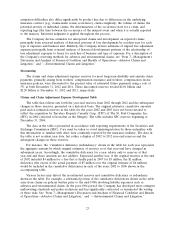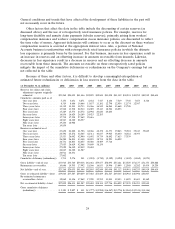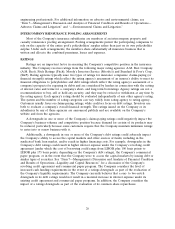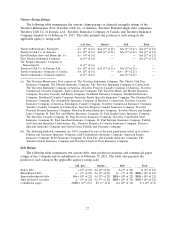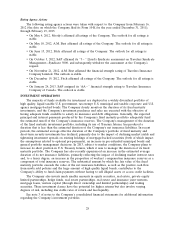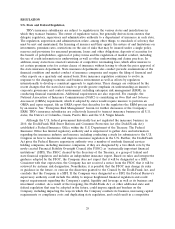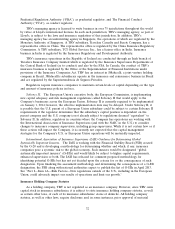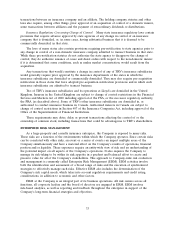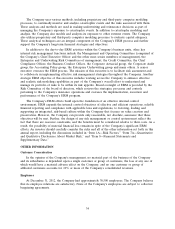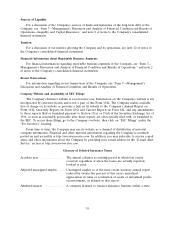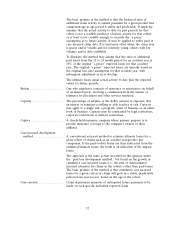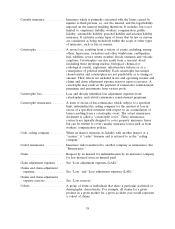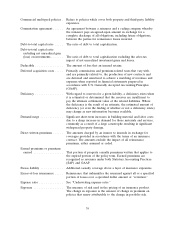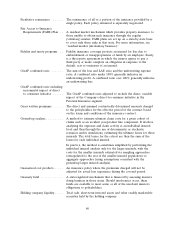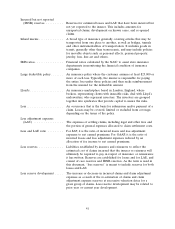Travelers 2012 Annual Report Download - page 43
Download and view the complete annual report
Please find page 43 of the 2012 Travelers annual report below. You can navigate through the pages in the report by either clicking on the pages listed below, or by using the keyword search tool below to find specific information within the annual report.Insurance Regulatory Information System. The NAIC developed the Insurance Regulatory
Information System (IRIS) to help state regulators identify companies that may require special
attention. Financial examiners review annual statements and key financial ratios based on year-end
data. These ratios assist state insurance departments in executing their statutory mandate to oversee
the financial condition of insurance companies. Each ratio has an established ‘‘usual range’’ of results.
A ratio result falling outside the usual range of IRIS ratios, however, is not considered a failing result;
rather, unusual values are viewed as part of the regulatory early monitoring system. Furthermore, in
some years, it may not be unusual for financially sound companies to have several ratios with results
outside the usual ranges. Generally, an insurance company will become subject to regulatory scrutiny if
it falls outside the usual ranges of four or more of the ratios.
Based on preliminary 2012 IRIS ratios calculated by the Company for its lead insurance
subsidiaries, The Travelers Indemnity Company and St. Paul Fire and Marine Insurance Company had
results outside the normal range for one IRIS ratio due to the size of their investments in certain
non-fixed maturity securities.
In 2011, The Travelers Indemnity Company and St. Paul Fire and Marine Insurance Company had
results outside the normal range for one IRIS ratio due to the size of their investments in certain
non-fixed maturity securities. Travelers Casualty and Surety Company and The Standard Fire Insurance
Company had results outside the normal range for two IRIS ratios due to the amount of dividends paid
to their respective parent. Additionally, Travelers Casualty and Surety Company had results outside the
normal range for one IRIS ratio due to the amount of dividends received from its subsidiaries.
Management does not anticipate regulatory action as a result of the 2012 IRIS ratio results for the
lead insurance subsidiaries or their insurance subsidiaries. In all instances in prior years, regulators
have been satisfied upon follow-up that no regulatory action was required.
Risk-Based Capital (RBC) Requirements. The NAIC has an RBC requirement for most property
and casualty insurance companies. The RBC requirement determines minimum capital requirements
and is intended to raise the level of protection for policyholder obligations. Under laws adopted by
individual states, insurers having total adjusted capital less than that required by the RBC calculation
will be subject to varying degrees of regulatory action, depending on the level of capital inadequacy.
The formulas have not been designed to differentiate among adequately capitalized companies that
operate with levels of capital above the RBC requirement. Therefore, it is inappropriate and ineffective
to use the formulas to rate or to rank these companies. At December 31, 2012, all of TRV’s insurance
subsidiaries had total adjusted capital in excess of the RBC requirement.
Investment Regulation. Insurance company investments must comply with applicable laws and
regulations which prescribe the kind, quality and concentration of investments. In general, these laws
and regulations permit investments in federal, state and municipal obligations, corporate bonds,
preferred and common equity securities, mortgage loans, real estate and certain other investments,
subject to specified limits and certain other qualifications. At December 31, 2012, the Company was in
compliance with these laws and regulations.
International Regulation
TRV’s insurance underwriting subsidiaries based in the United Kingdom, Travelers Insurance
Company Limited and Travelers Casualty and Surety Company of Europe Limited, are regulated by the
Financial Services Authority (FSA). The FSA’s principal objectives are to maintain market confidence,
promote public understanding of the financial system, protect consumers, and fight financial crime.
TRV’s managing agency (Travelers Syndicate Management Ltd.) of its Lloyd’s syndicate is also
regulated by the FSA, which has delegated certain regulatory responsibilities to the Council of Lloyd’s.
During 2013, the role of the FSA as insurance regulator will be replaced by two successor bodies, The
31




